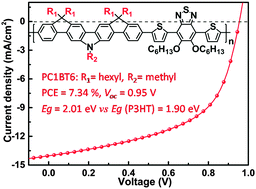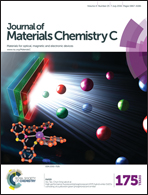Side-chain engineering of diindenocarbazole-based large bandgap copolymers toward high performance polymer solar cells†
Abstract
Five wide bandgap conjugated polymers based on diindenocarbazole (DIC) and dithienylbenzothiadiazole (DTBT) alternating units have been designed and prepared to investigate the effects of side chains on the photovoltaic performance of the polymers. All the polymers are soluble in common organic solvents and they show similar optical bandgaps of around 2.0 eV as well as deep-lying highest occupied molecular orbital (HOMO) energy levels (below −5.48 eV). Bulk heterojunction (BHJ) polymer solar cells (PSCs) using phenyl-C71-butyric acid methyl ester (PC71BM) as the electron acceptor material were fabricated. The side chains on the polymer backbone have a strong impact on the film morphology of the polymer:PC71BM blends. A phase separation with a relatively larger domain size was found for the polymers with longer side chains, while those with relatively shorter alkyl chains could form uniform films featuring a phase separation with a smaller domain size. Finally, PSCs based on PC1BT6:PC71BM exhibited an outstanding power conversion efficiency of 7.34% with a high open-circuit voltage (Voc) of 0.95 V. Our results demonstrate that the judicious design of side-chains is effective in improving the photovoltaic performance of DIC-based polymers. With a larger bandgap than P3HT but an improved power conversion efficiency (PCE) with a large Voc, this type of DIC-based polymer should be a promising bottom layer material for tandem solar cells.


 Please wait while we load your content...
Please wait while we load your content...